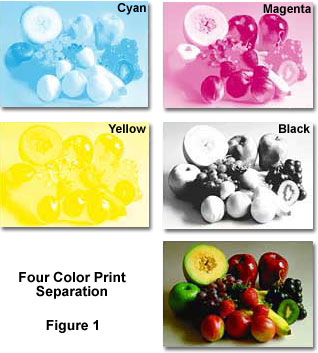Interactive Java Tutorials
Color Separation
Pigments and dyes are responsible for most of the color that humans see in the real world. Books, magazines, signs, and billboards are printed with colored inks that create colors through the process of color subtraction. This interactive tutorial explores how individual subtractive primary colors can be separated from a full-color photograph, and then how they can be reassembled to create the original scene.
The tutorial initializes with a color photograph of mixed fruit displayed in the upper left-hand corner of the tutorial window. Adjacent to and below the full color photograph are the four individual color separations that result from dissecting the image into cyan (C), magenta (M), yellow (Y), and black (K) components. In order to operate the tutorial, use the mouse cursor to superimpose the color separations over one another. As additional separations are added, the resulting image acquires the realism evident in the color photograph.
When any two of the primary subtractive colors are added, they produce a primary additive color. For example, adding magenta and cyan together produces the color blue, while adding yellow and magenta together produces red. In a similar manner, adding yellow and cyan produces green. When all three primary subtractive colors are added, the three primary additive colors are removed from white light leaving black (the absence of any color). White cannot be produced by any combination of the primary subtractive colors, which is the main reason that no mixture of colored paints or inks can be used to print white.
Human eyes, skin, and hair contain natural protein pigments that reflect the colors we see in the people around us (in addition to any assistance by colors used in facial makeup and hair dyes). Modern color desktop printers create beautiful prints that are produced with colored inks through the process of color subtraction. In a similar manner, automobiles, airplanes, houses, and other buildings are coated with paints containing a variety of pigments. The concept of color subtraction, as discussed above, is responsible for most of the color produced by the objects just described. For many years, artists and printers have searched for substances containing dyes and pigments that are particularly good at subtracting specific colors.

All color photographs, and other images that are painted or printed, are produced using just four colored inks or dyes: magenta, cyan, yellow (the subtractive primaries) and black (see Figure 1). Mixing inks or dyes having these colors in varying proportions can produce the colors necessary to reproduce just about any image or color. The three subtractive primaries could (in theory) be used alone, however the limitations of most dyes and pigments makes it necessary to add black to achieve true color tones. When an image is being prepared for printing in a book or magazine, it is first separated into the component subtractive primaries, either photographically or with a computer as illustrated above in Figure 1. Each separated component is made into a film that is used to prepare a printing plate for that color. The final image is created by sequentially printing each color plate, one on top of another, using the appropriate ink to form a composite that recreates the appearance of the original. Paint is also produced in a somewhat similar manner. Base pigments containing the subtractive primaries are mixed together to form the various colors used in final paint preparations.
Contributing Authors
Matthew J. Parry-Hill, Robert T. Sutter and Michael W. Davidson - National High Magnetic Field Laboratory, 1800 East Paul Dirac Dr., The Florida State University, Tallahassee, Florida, 32310.
